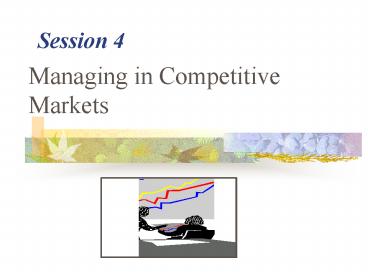Managing in Competitive Markets - PowerPoint PPT Presentation
1 / 28
Title:
Managing in Competitive Markets
Description:
What level of Q to max profits or minimize losses? ... price takers but there are barriers to entry, profits will persist ... Short run profits leads to entry ... – PowerPoint PPT presentation
Number of Views:50
Avg rating:3.0/5.0
Title: Managing in Competitive Markets
1
Session 4
- Managing in Competitive Markets
2
Overview
- Production and Costs
- Perfect Competition
- Characteristics and profit outlook
- Effect of new entrants
3
Production Function
- Managers job is to use available production
function efficiently - Decide how much of each input (labor and capital)
to use - Depends on whether inputs are fixed or variable
- Depends on whether inputs are being used in the
short run vs. long run
4
Marginal Product of Labor
- MPL DQ/DL
- Measures the output produced by the last worker.
- Slope of the production function
5
Role of Manager in Production Process
- Ensure that the firm is operating on production
function - Providing workers with the right incentives
- Ensure that the firm uses correct level of inputs
- Hiring the right number of workers to maximize
profits
6
Cost Analysis
- Types of Costs
- Fixed costs (FC)
- Variable costs (VC)
- Total costs (TC)
- Sunk costs
7
Total and Variable Costs
C(Q) Minimum total cost of producing
alternative levels of output C(Q) VC
FC VC(Q) Costs that vary with output FC
Costs that do not vary with output
8
Fixed and Sunk Costs
FC Costs that do not change as output
changes Sunk Cost A cost that is forever lost
after it has been paid
C(Q) VC FC
VC(Q)
FC
Q
9
Some Definitions
Average Total Cost ATC AVC AFC ATC
C(Q)/Q Average Variable Cost AVC
VC(Q)/Q Average Fixed Cost AFC FC/Q Marginal
Cost MC DC/DQ
ATC
AVC
AFC
10
Fixed Cost
Q0?(ATC-AVC) Q0? AFC Q0?(FC/ Q0) FC
ATC
Fixed Cost
AFC
AVC
Q0
11
Variable Cost
Q0?AVC Q0?VC(Q0)/ Q0 VC(Q0)
AVC
Variable Cost
Q0
12
Total Cost
Q0?ATC Q0?C(Q0)/ Q0 C(Q0)
ATC
Total Cost
Q0
13
Perfect Competition
- Many buyers and sellers
- Homogeneous product
- Perfect information
- No transaction costs
- Free entry and exit
14
Key Implications
- Firms are price takers (P MR)
- In the short-run, firms may earn profits or
losses - Long-run economic profits are zero
- Worksheets, pp. 4-2 4-3
15
Unrealistic? Why Learn?
- Many small businesses are price-takers, and
decision rules for such firms are similar to
those of perfectly competitive firms - It is a useful benchmark
- Explains why governments oppose monopolies
- Illuminates the danger to managers of
competitive environments - Importance of product differentiation
- Sustainable advantage
16
Managing a Perfectly Competitive Firm (or
Price-Taking Business)
17
Setting Price
18
Setting Output
- MR MC
- MR P, therefore
- Set P MC to maximize profits
19
Graphically
Profit (Pe - ATC) ? Qf
Pe Df MR
Pe
ATC
Qf
20
A Numerical Example
- Given
- P10
- C(Q) 5 Q2
- Optimal Price?
- P10
- Optimal Output?
- MR P 10 and MC 2Q
- 10 2Q
- Q 5 units
- Maximum Profits?
- PQ - C(Q) (10)(5) - (5 25) 20
21
Short-Run Analysis
- How does a firm minimize losses?
- Firm should produce when it covers its variable
costs - Demo Prob.8-2, page 277
- C(Q) 100 Q2
- P 10
- What level of Q to max profits or minimize losses?
22
Short Run Supply Curve of the Competitive Firm
- Firms MC curve gt minimum of AVC is the firms
short run supply curve - Where MC AVC is the firms shut-down point
23
Long Run Adjustments?
- If firms are price takers but there are barriers
to entry, profits will persist - If the industry is perfectly competitive, firms
are not only price takers but there is free entry - Other greedy capitalists enter the market
24
Effect of Entry on Price?
S
Entry
Pe
Df
25
Effect of Entry on the Firms Output and Profits?
26
Summary of Logic
- Short run profits leads to entry
- Entry increases market supply, drives down the
market price, increases the market quantity - Demand for individual firms product shifts down
- Firm reduces output to maximize profit
- Long run profits are zero
27
Features of Long Run Competitive Equilibrium
- P MC
- Socially efficient output
- P minimum AC
- Efficient plant size
- Zero profits
- Firms are earning just enough to offset their
opportunity cost
28
Relevant Articles
- Dynamics of Competition at Amazon.com, p. 4-8
- Perfect Competition, Zero Profit, p. 4-9































